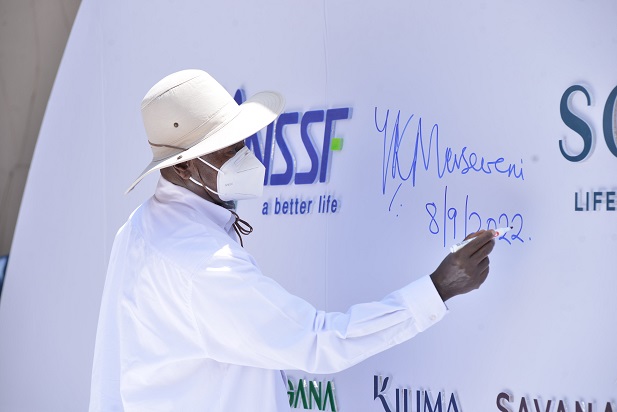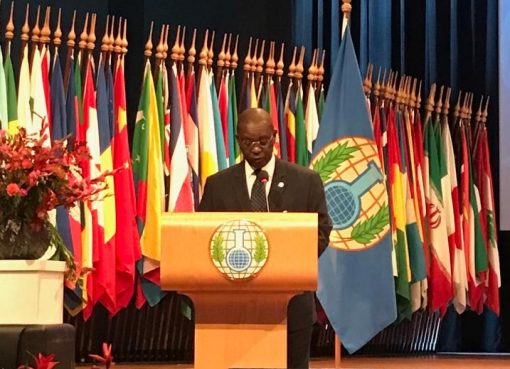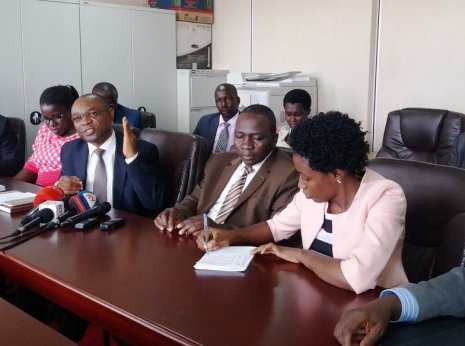President Museveni officially launching NSSF’s housing project named Solana Lifestyle & Residences
President Yoweri Museveni Thursday launched the National Social Security Fund’s Housing Project in Lubowa, a Kampala Suburb off Entebbe Road, saying that collective savings can play a big role in the country’s economic development.
He commended NSSF for increasing its assets from Shs1.2 trillion to the current Shs17 trillion. He encouraged Ugandans to save in groups.
“You are going to have a new city here built by the NSSF,” the President said in reference to the 600 acres NSSF acquired in Lubowa for the housing project.
He commended NSSF for buying the land, noting that it was a huge investment and it’s located in a good area.
The NSSF Managing Director, Richard Byarugaba said the first phase of the Solana Lifestyle and Residences is only 10% (60 acres) of the 600 acres and consists 306 housing units.
After competition, this will be the largest project in East Africa, comprising of 2,750 residences, apartments, townhouses, bungalows, and villas.

Byarugaba added that the Fund has injected US$73.3m (UShs278.9bn) in the first phase, creating 1,500 and 3,200 direct and indirect jobs respectively.
He noted that US$1.3m went into infrastructure while US$31m went into Ugandan companies, supporting the Buy Uganda Build Uganda policy.
The entire project (sitting on 600 acres) is expected to cost US$400m (Shs1.52 trillion).
The contractors of the project include PCCC, CRJE, Seyani and Cementers while Consultants are SBI and TMA.
“We have worked on roads, power, internet, water and we shall have our own sewerage treatment plant,” Byarugaba said, adding that they will also have schools, gyms, hospital, fire station and a recreation centre among other facilities.
The NSSF boss listed land fraud, fights among bidders, red tape from NEMA, City Authority and high VAT as key challenges they are facing in implementing the various housing projects.
He also proposed the creation of a mortgage bank, Uganda Mortgage Refinance Company/bank to handle issues of credit that is a big limiting factor in growing the mortgage industry in the country.
Cost of Housing Units
Byarugaba said the housing units can be acquired through rent to own model, where by a customer can make a down payment of 10-20% and pay rent until the agreed amount is completed.
“We are going to begin selling and then we begin to make a profit and return to our members. The returns are in double digits and we believe that this is a good opportunity for us to showcase to the world what NSSF can do,” he said, adding that the cost of the two or three housing units for the high end market will be in the region of US$150,000 (UShs570.9m) to US$180,000 (UShs685.1m).

He said they plan to have other projects for the lower market in places like Kyanja where the completion rate of the project is at 60% while the Temangalo project will have 5,000 units and is 30% complete. He said the units in Kyanja and Temangalo will cost between US$30,000 (UShs114m) and US$40,000 (152m).
President Museveni responded to Byarugaba’s presentation, saying he (Byarugaba) is a good manager but not a strategist. He said that once majority of Ugandans are into the money economy, the challenges the NSSF boss raised will be easier to solve.
“What the NRM is struggling with is to get the whole society into the money economy. By 1969, the households which were in the money economy were only 4%. 96% of the homesteads were working for only the ‘stomach’. By 2013, 68% of the homesteads were still in the non monetary GDP (working only for the stomach). This is how I involved the army from 2013 and now that figure has gone down to 39%. For the first time, 61% of the homesteads are in the money economy. We are determined to win over even the remaining 39%. Once the base of the society goes into the money economy, that is the success we need,” the President said.
Museveni added that once all homesteads; all the nine million homesteads are mobilized to get “involved in commercial agriculture or in manufacturing either as owners or employees, in artisanship, in services like boda bodas, hospitality and entertainment industry and ICT sector, then those tactical issues are easy to solve. For instance, one of VAT on owner occupied buildings that can be dealt with because he (the owner) is not going to rent.”
Museveni also said the laws can be amended to deal with fraudsters.
“Even fraudsters; those who come and tell lies and so on, we can amend laws and ensure that the project goes on even if someone is claiming; he can continue claiming while the project is going on because injunctions are very disruptive. If you have got a case, let me continue with the project. If you win in future, I can compensate you when the project is already finished,” Museveni said.
Finance Minister, Matia Kasaija invited the NSSF management for a meeting in order to solve the challenges the Fund is facing in implementing its housing projects.







I applaud NSSF for this…however i think if well planned and with this kind of money, NSSF would have built a new city in Hoima, kabaale near the airport because the land is still cheap and we expect hundreds of thousands of people when drilling and oil production starts.
Just the price of land in Lubowa would have built thousands of units in Hoima that will even fetch better premiums in rent.
Goodafternoon, me I want know like us low earners but we have savings with u how are we going to benefit , why can’t u have the units of 60 to 75m.thx God bless u all, and if I want to acquire it how much do u need so that I can plan .